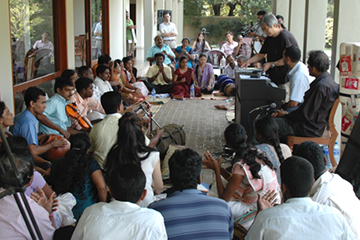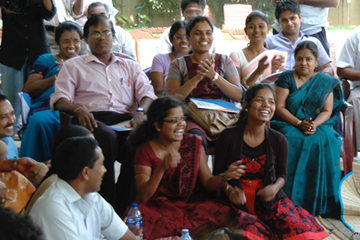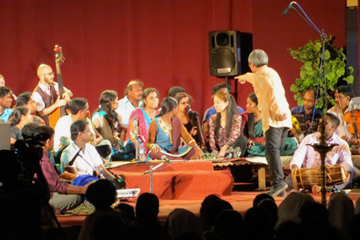Emotion and Logic: The Communication Art of Randooga
Ashiwa Yoshiko (Japan)
Professor, Graduate School of Social Sciences, Hitotsubashi University
In the social sciences, which seeks to explain the complexities of our world through the conventions of language, it is vital to have clear, concise analyses and explanations. Scholars, then, always grapple with the challenges of organizing discrete, emotional experiences into systematic constructs with broad applicability. But does the world we inhabit really abide by that logical consistency, a universal rationality? In reality, our world is an emotional realm of irrationality and inconsistency. Violence and conflict—and coexistence and reconciliation, for that matter—all stem from the human mind and human society, rooted firmly in the world of emotion. That emotional dimension remains unexplored territory among social scientists, however—and that relative dearth reflects the difficulties inherent in exploring the world of emotion with the tools of language and logic.
The importance of art is gaining broader recognition throughout society. The more you probe that emotional sphere, though, the more you recognize that the linguistic and logical frameworks of the social sciences can only capture so much. I’ve researched Sri Lanka for many years, examining anthropologically the emotional experiences of the escalation of the country’s civil war, and the issues of violence and politics that are shaping popular performing art and ritual, local cultural, and religious representations, as well as fine arts. Navigating those dynamics has always been a confusing journey: I’ve had to maneuver between the field, a swirling vortex of emotion, and the social sciences, a confining cage of incomplete logic. Organizing small art-related events has helped me bridge those gaps, in certain ways. The project that left the most lasting impressions on me was the “Randooga” initiative—a sound-based communication project that visited several former war zones in Sri Lanka from 2012 to 2014.
The Sri Lankan Civil War ended in 2009. In the years since, Sri Lankan artists have channeled their memories of violence into a plethora of artwork that has garnered renown worldwide. Art bring fames—but does it bring actual relief and reconciliation to the nameless victims and divided communities that the war left in its wake?
My experience of the civil war goes back roughly 40 years, all the way to its beginnings in the early 1980s. As I tracked the developments as a researcher, the country descended into murky depths where the path forward was impossible to see—but there were occasional gleams of light, fleeting moments of human trust that I hoped could build into a foundation for a happier, safer society. The official end of the armed conflict in 2009 may have ushered in a nominal peace, but the culmination cleaved deep rifts between ethnicities, communities, and even individual people. All the people from Sri Lanka and around the world who played a role in the peaceful resolution, and I, too, still knew in the backs of our minds that the peace came about through violence. Despite that pervading pain and loss, we kept looking for something that we could do.
That’s when the Randooga project started to materialize. Sponsored by the Japan Foundation with the help of the Embassy of Japan in Sri Lanka, local universities, and musicians and NGOs from Sri Lanka and around the world, I formulated the initiative around Randooga: the innovation of world-renowned pianist Masahiko Sato, a free-jazz pioneer. Sato’s vision, operating on the concepts of improvisational jazz, was to create a sound-based communication method, one where people use any tools that make sounds to exchange ideas—regardless of their musical experience. The project drew a diverse mix of participants, including a professional percussionist and vocalists from Japan along with the eminent sitarist, Dr. Pradeep Ratnayake, and a tabla player from Sri Lanka, and a total audience of more than 4,500 at performances in four locations nationwide. The participants started with workshop of a few days, laying the groundwork for stirring, joyous improvisation. The basics of a Randooga performance are simple. Every performer uses whatever they can, be it an instrument, their voice, a pot, a bottle, or anything else, to create short phrases of sound or rhythms. Listening to the sounds and rhythms coming from other players, the performers respond freely with their own expressions. It’s like a conversation: a performer might respond to another player’s expression with a musical “nod,” an imitation, a new statement, a comeback—and all without using any verbal language, of course. You play a phrase—someone might hear it and echo your call; someone might rephrase it; someone might hear that rephrasing and transform it again; the group, through that interaction, gives shape to entirely new expressions in fluid conversation. There’s no such thing as a “good” or “bad” Randooga performer. A cool phrase might prove popular, but no single player can ever commandeer the performance. The whole point is to create a passage of sound as a collective, an aural flow of improvisation that hinges on the group dynamic.

Participants are listening to Mr. Sato’s instructions attentively.
The most impressive workshop was the first one in Jaffna, an area populated by Tamils in northern Sri Lanka where intense fighting dragged on for years. The workshop participants were wary at first; the fact that some spoke Sinhalese while others spoke Tamil made for an obvious communication gap. With Sato leading the way, however, they quickly focused on learning the Randooga method. Once they gradually started conversing with each other in sound, the performers started laughing together like old childhood friends. The whole venue resonated with an unmistakable brightness, the visceral joy of wordless communication.

faces as soon as their sonic and vocal communications begin.
Three days later, the participants gave a performance at a shelled-out hall that the community had quickly patched back into shape. The sounds filled the space as the players built on each other’s phrases, sending a stream of unifying joy through the audience. Words can’t express what it was like—the video is much better. (To see the video, please click here.)

With cues from Mr. Sato, players take turns to improvise.
It was the first large performance organized by ordinary citizens at the refurbished hall, and the improvisations transcended the concepts of music people have was the first experiences for them, all of which excited audience immensely. Audience members, even the school principal and nuns accompanying a group of middle-school students, let their bodies bounce and sway to the rhythms. The people there had suffered through the terrors of a civil war. For most of them, the terrors and pains had yet to end. At the Randooga workshop and concert, though, they had smiles beaming across their faces. It was a miracle—a momentary one, of course, but an inspiring testament to how communication can foster trust and confidence and wonder.
However, the issue for us lies in the next step. After the concert, the representative for UNICEF in Sri Lanka rushed over to me and said, “You could take this global. You should establish a method and start expanding.” Other people echoed the same idea: NGO representatives and music instructors from Jaffna wanted a documented method so that they could keep doing more Randooga after we left. We’d distributed a basic guide in Sinhalese, Tamil, and English for use at the workshop, but no one—not even Sato—had ever put the system and method into a package that anyone could read and turn into their own Randooga. Like any form of improvisational jazz, Randooga is an art form where a one-time-only character plays a core role. The performance in Jaffna was the singular product of numerous unique circumstances: the leadership of Masahiko Sato, a one-of-a-kind talent; the local community’s hunger to engage in meaningful dialogue and reclaim their self-respect; the performers’ familiarity with the sitar and indigenous instruments; the playfulness of neighbors making sounds onstage together; the efforts of facilitators with intimate knowledge of the people; the financial backing of the Japan Foundation; the sense of political security that the Japanese embassy brought; the uniquely foreignizing effect of having musicians from Japan and other countries on hand; the gravity of holding the event in a hall that represented Jaffna’s weakened—but ever-beating—musical heart.
What makes Randooga special is the nature of improvisation—the energy and emotion of unpredictability on a common foundation. Aware of those vital elements, Sato knows how hard it would be to frame the art form in a logical, written text. The processes of creating emotion and theorizing emotion are completely different, making it impossible to put the explanation-defying energy of Randooga in words—no matter how thoroughly and logically you analyze it. Going “by the book,” if there were one, would never be enough to unleash that Randooga magic. The disconnect between emotion and logic isn’t just a problem in the social sciences, obviously. That said, our increasingly segmented world has made Randooga’s brand of word-independent communication crucial for so many people. To help people keep connecting through Randooga, we might just have to find a way to fit the art into the trappings of verbal logic. While that process might be infinitely harder than analyzing emotion from a social-science standpoint, it would certainly be a meaningful effort. Modern art, I believe, has the power to ease the pain of the nameless multitudes, to reunite divisions directly if it uses its skill, and if it wishes. We can’t forget that.
The contents of this article reflect solely the opinions of the author.



